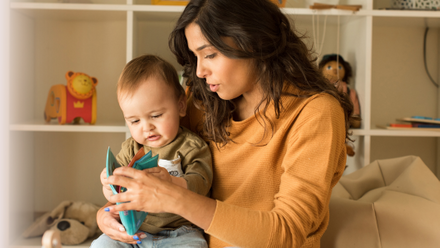How to use the STAR method in job applications and interviews
Transferable skills are highly valuable in early education and care because they enable professionals to adapt to the diverse and evolving challenges that we often find in our exciting work. Skills such as effective communication, teamwork, problem-solving and adaptability are crucial in this field, where effective partnerships with parents and carers, as well as the wider team, are needed to ensure we are providing the best start for the children in our care. Transferable skills not only enhance the quality of the provision, but also support professionals’ growth, making educators more versatile and resilient throughout their career.
Working in the everyday of early education and care, implementing these skills becomes a natural part of what we do. So, when it comes to branching out and applying for new roles, it can be difficult to pinpoint exact moments and skills to demonstrate what we bring to the job.
The STAR method is a widely acknowledged way to provide tangible examples of the skills we highlight in job applications. In this learning workout, we are going to look at how you can use the STAR method specifically for working in early education and care.
What is the STAR method?
The STAR method is a recommended structure for thinking about ways to demonstrate skills throughout the recruitment process: from CV building to interview technique, this method provides a useful way to think about how the skills are demonstrated and the precise reasons they make you a valuable member of the team.
STAR stands for:
Situation: what was the situation you were in?
Task: what was the task you were given/you decided to carry out?
Action: what actions did you take in response to this task?
Result: what happened because of the actions you took and how did you reflect on this?
Let’s have a look at how this can be used within early education and care.
Applying the STAR method
A common essential skill found in job descriptions for early education and care roles is an ability to communicate effectively. Let’s use this example to walk through the STAR method.
Situation: what was the situation you were in?
The situation relates to the context you were in. This gives the audience a better understanding of the external pressures you might face at the time, aside from the task you talk about.
For example, your context might be:
I am currently the room lead in a baby room of up to six children daily, aged between four and eighteen months. Alongside me, I currently have an unqualified member of staff who is undergoing their apprenticeship for level 2 in childcare. In this example, we had four babies in the room and had a settling session prepared for a new six-month-old baby due to join us in the coming weeks. This was the baby’s second session so meant it was a time that she would be left in the room with us without her mother present, unlike the first session which was held with mum in attendance.
Task: what was the task you were given/did you decide to do?
The task explores the specific challenge you faced. This might be due to your responsibilities in the role or an unpredicted challenge that you met as a team.
For example, the task may be:
As room lead, I was responsible for meeting and greeting the mother and baby at the door, and explaining how the session would be coordinated. When we got up to the room, the baby was quite distressed and, as her new key worker, I was responsible for her settling session. Some time in, we received a call to the nursery from the mother, informing us she was outside and could still hear her baby crying. She was very upset.
Action: what actions did you take in response to this task?
The action refers to the actions taken in direct response to the task or challenge at hand. This might include actions you personally took or ways you supported others with an action.
For example, an action might look like:
I responded to this when it was appropriate to do so. Whilst management took the phone call itself, my priority is to be with the child at that moment. However, I was able to spend time at the end of the settling session to talk to the mom. I was able to have a detailed conversation with the mother afterwards about how the session had gone and remained positive and encouraging about the progress that had been made. For example, whilst the little girl had been extremely distressed during the initial stages of the settle, by exploring toys and trying different sensory techniques, whilst following the guidance of her original interview with her parents, we were able to navigate a safe environment through the use of musical instruments.
Result: what happened because of the actions you took and how did you reflect on this?
The result is all about what happened due to the decisions you made. This might be entirely positive or negative but, importantly, it allows you to provide a reflection of the results and how you could improve your wider practice because of it. Showing you have used an experience to take further action is a great way to use to STAR method to show your intentions for professional development.
For example, your results might look like:
As a result, the mother was encouraged by our efforts and understanding of the capacity for young children to regulate their emotions in unfamiliar situations. We were able to build on our initial conversations to develop a more detailed plan for responding to the baby’s distress and this resulted in a quick and effective settle both for baby and mother.
Reflecting on this, I was able to review our current settle strategy to give more time to settles with the families and expand on the individual requirements of the children, specifically those within the baby room and their unique, ever-changing needs.
Final thoughts
The STAR method is widely used as a helpful structure for compiling evidence that shows how we use valuable skills throughout our work. It allows us to provide specific and direct examples of the work we do, to avoid waffling and to be precise in the outcomes we achieve as a result.
However, the STAR method can be overused, resulting in a robotic and formulaic sense of structure to our applications. It puts us in danger of focusing on our own contributions too much and not giving enough context to fully show how the wider team may have helped too.
Think about how you can use the STAR method in your next application by completing the activity below.
Reflection
Think of a specific challenge to answer the following question, which is a common question in job interviews, and map out an answer using the STAR method.
“Please tell us about a time you were faced with a challenge that was not expected and resulted in you having to react in the moment”
THINK STAR:
-
Situation: what was the situation you were in?
-
Task: what was the task you were given/did you decide to do?
-
Action: what actions did you take in response to this task?
-
Result: what happened because of the actions you took and how did you reflect on this?






